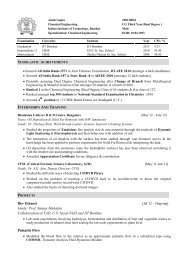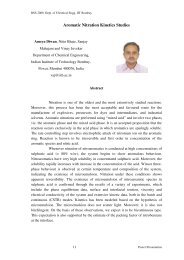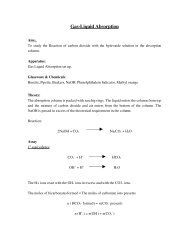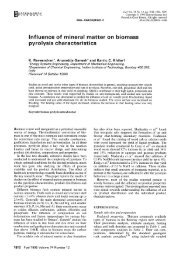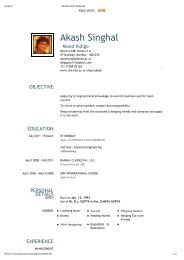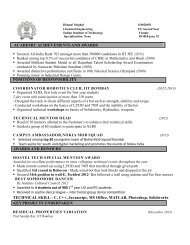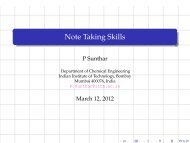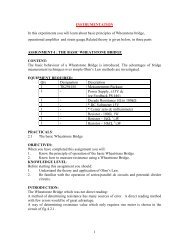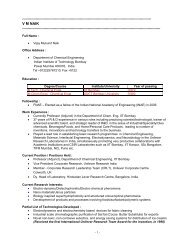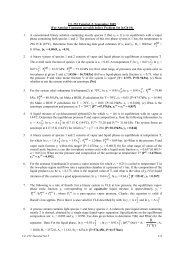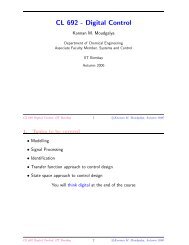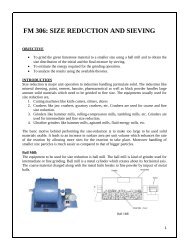Prof HS Shankar - Chemical Engineering, IIT Bombay
Prof HS Shankar - Chemical Engineering, IIT Bombay
Prof HS Shankar - Chemical Engineering, IIT Bombay
Create successful ePaper yourself
Turn your PDF publications into a flip-book with our unique Google optimized e-Paper software.
SOIL BIOTECHNOLOGY OF <strong>IIT</strong>, BOMBAY<br />
<strong>Prof</strong> H.S.<strong>Shankar</strong> - hss@iitb.ac.in<br />
Department of <strong>Chemical</strong> <strong>Engineering</strong><br />
<strong>IIT</strong>-<strong>Bombay</strong><br />
Tel No 91-22-25767239,25768239
• PRINCIPLES<br />
CONTENTS<br />
• WATER PURIFICATION<br />
• PROCESSING OF SOLID RESIDUES<br />
• AGRICULTURE<br />
• SUMMING UP
A natural water body
A river system once a life line now in in distress due<br />
to to nutrient overload from agriculture
A natural water body in in the process of of decay
A natural water body converted to to land due to to<br />
nutrient overload
6<br />
Photosynthesis<br />
Fossil<br />
Fuels<br />
4,000<br />
110<br />
Plants<br />
500<br />
CO2 in the<br />
Atmosphere<br />
750<br />
(1- 10 y)<br />
50<br />
Dead Organics in<br />
Soil (1 y)<br />
50 18<br />
Dead Organics<br />
Reserve in Soil<br />
1,576<br />
(300 y)<br />
Respiration<br />
Animals<br />
100-150<br />
(50 y) (2 y)<br />
Global Carbon Cycle (Meilli, 1995)<br />
CO 2 Dissolved<br />
4,000<br />
Live 1-5<br />
Quantities in 10 15 g<br />
Source:<br />
Source:<br />
Encyclopedia<br />
Encyclopedia<br />
of<br />
of<br />
Environmental<br />
Environmental<br />
Biology,<br />
Biology,<br />
Vol.1,<br />
Vol.1,<br />
Academy<br />
Academy<br />
press,<br />
press,<br />
1995,<br />
1995,<br />
pp.235-248<br />
pp.235-248<br />
90<br />
50 - 65<br />
(0.2 y)
ENERGY CONSUMPTION IN DIFFERENT HABITATS<br />
1. Water 500 kJ/g live C. yr<br />
2. Land 3 kJ/g live C. yr
SCHEMATIC OF WATER RENOVATION<br />
Recycle (vr )<br />
C 1<br />
Feed (vf )<br />
Reactor<br />
C 2<br />
Discharge (vf )<br />
1.Raw water<br />
2.Raw Water slurry<br />
3. Air scrubbing<br />
4. Leachates of solids<br />
5. Waste water
T1 R1 T2 R2 T3 R3 T4 T 1<br />
SCHEMATIC OF MULTISTAGE PURIFICATION<br />
R 1<br />
T 2<br />
R 2<br />
T 3<br />
R 3<br />
T 4
LARGE SCALE FACILITY FOR SEWAGE RENOVATION
Respiration<br />
MAJOR CHEMICAL REACTIONS AT WORK<br />
(CH 2 ON x P y S z K y Q) n + nO 2 + nH 2 O + Micro-organisms =<br />
Photosynthesis<br />
nCO 2 + 2nH 2 O + Mineral (N, P, S, K,Q) + Energy<br />
nCO 2 + 2nH 2 O + Minerals (N,P, S,K,Q) + Sunlight =<br />
<strong>Chemical</strong> Mineral weathering<br />
CO 2 + H 2 O = HCO 3 - + H +<br />
[CH 2 ON x P y S z K y Q] n + nO 2 + nH 2 O<br />
Primary mineral + CO 2 + H 2 O = M +n + n HCO 3 - + soil/sand/clay
BIOMASS YIELD, MINERAL CONTENT, NITROGEN<br />
CONTENT, WATER CONSUMPTION FOR SOME CROPS<br />
Crop Mineral<br />
% DM<br />
N<br />
% DM<br />
Water<br />
ton / ton DM<br />
Yield<br />
ton DM / ha<br />
Subabul 0.5 – 0.8 Small 50 20<br />
Sugarcane 1.5 – 2.0 Small 400 18<br />
Corn 5.0 – 6.0 0.3 – 0.5 200 14<br />
Wheat 9 – 11 0.3 – 0.5 600 12<br />
paddy 18 - 20 0.3 – 0.5 1000 9<br />
DM – Dry Matter<br />
* *<br />
Yield is total biomass-grain, straw etc.
CHEMISTRY OF SBT<br />
Respiration<br />
(CH 2 ON x P y S z K y ) n + nO 2 + nH 2 O = nCO 2 + 2nH 2 O + Mineral (N, P, S, K) + Energy (1)<br />
Photosynthesis<br />
nCO 2 + 2nH 2 O + Minerals (N,P, S,K) + Sunlight =<br />
[CH 2 ON x P y S z K y ] n + nO 2 + nH 2 O (Photosynthesis) (2)<br />
Nitrogen Fixation<br />
N 2 + 2H 2 O + Energy = NH 3 + O 2 ( in soil) (3)<br />
N 2 + 2H 2 O + Light = NH 3 + O 2 (in water) (4)<br />
Acidogenesis<br />
4C 3 H 7 O 2 NS + 8H 2 0 = 4CH 3 COOH + 4CO 2 + 4NH 3 + 4H 2 S + 8H + + 8e - (5)<br />
Methanogenesis<br />
8H + + 8e - + 3CH 3 COOH + CO 2 = 4CH 4 + 3CO 2 + 2H 2 O (6)<br />
Adding 5 and 6 give overall biomethanation chemistry<br />
4C 3 H 7 O 2 NS + 6H 2 0 = CH 3 COOH + 6CO 2 + 4CH 4 + 4NH 3 + 4H 2 S (7)<br />
Mineral weathering<br />
CO 2 + H 2 O = HCO 3 - + H + (8)<br />
Primary mineral + CO 2 + H 2 O = M +n + n HCO 3 - + soil/clay/sand (9)<br />
Nitrification<br />
NH 3 + CO 2 + 1.5O 2 = Nitrosomonas + NO 2 - + H2 O + H + (10)<br />
NO 2 - + CO2 + 0.5O 2 = Nitrobacter + NO 3 - (11)<br />
Denitrification<br />
4NO 3 - + 2H2 O + energy = 2N 2 + 5O 2 + 4OH - (12a)<br />
NO 2 - + NH4 + = N2 + H 2 O + energy (12b)
The trinity – showing importance of of combining<br />
organics, inorganics & suitable life forms to to derive<br />
value from wastes
Crop<br />
Wheat<br />
(USA)<br />
Wheat<br />
(India)<br />
Rice<br />
(USA)<br />
Rice<br />
(Phil)<br />
Potato<br />
(USA)<br />
Cassava<br />
(Tanga)<br />
ENERGY CONSUMPTION FOR FOOD CROPS<br />
Energy Input<br />
M k cal / ha<br />
Fossil Labour Total<br />
Yield<br />
kg / ha<br />
Output<br />
M cal / ha<br />
Efficiency<br />
(-)<br />
3.77 0.002 3.772 2284 7.5 2.2<br />
0.256 0.1845 0.4405 821 2.7 6.25<br />
15.536 0.009 15.545 5796 21.0 1.35<br />
0.582 0.1728 0.754 1655 6.0 7.69<br />
8.90 0.018 8.92 26208 20.2 2.27<br />
0.016 0.385 0.401 5824 (Dry) 19.2 50.0<br />
Source: Energy in agriculture, Lockeritz (ed.) International Congress energy in agriculture Missouri,<br />
1975-76
Energy efficiency<br />
10<br />
9<br />
8<br />
7<br />
6<br />
5<br />
4<br />
3<br />
2<br />
1<br />
Direction of<br />
Increasing biological potential<br />
0<br />
0<br />
0 1.0 2.0 3.0 4.0 5.0 6.0 7.0<br />
Yield , Ton/ha<br />
Wheat,USA<br />
Rice,USA<br />
Potato,USA<br />
Wheat,India<br />
Rice,Phillipines<br />
Cassava,Tanga<br />
Yield -Efficiency correlation for some crops<br />
60<br />
50<br />
40<br />
30<br />
20<br />
10
Organics<br />
Residual<br />
organics<br />
Single-pass<br />
Bioreactor<br />
Gut residence<br />
time: about 5 h<br />
Anaerobic<br />
processing<br />
Biosoil<br />
incubation<br />
Loop<br />
Bioreactor<br />
Organics and rock<br />
particles<br />
Gut residence<br />
time: about 1 h<br />
Aerobic<br />
processing<br />
(Say Red worm) (Say Earthworm)<br />
Bioprocessing by by the the two two types types of of organisms<br />
Source: Bhawalkar (1996) (1996)<br />
Refeeding<br />
Pump is<br />
organism<br />
as mobile<br />
bioreactor
ECO-ENERGETICS OF AN EARTHWORM (Lavell, 1974)<br />
Fresh Weight mg/individual 1025<br />
Ingestion (J/g.d) 1570<br />
Assimilation (J/g.d) 140<br />
Production (J/g.d) 10<br />
Respiration (J/g.d) 130<br />
Egestion (J/g.d) 1430<br />
EXPONENTIAL GROWTH OF BACTERIA IN EARTHWORM GUT<br />
(no. in million) (Parle, 1959)<br />
Forgut Midgut Hindgut<br />
All Bacteria 475 32900 440900<br />
Actinomycetes 26 358 15000
pH<br />
11<br />
9<br />
7<br />
5<br />
3<br />
1<br />
Optimum<br />
Optimum<br />
Earthworm<br />
Termite Cockroach<br />
Rats, ants<br />
Fly Larvae<br />
Potworm<br />
20 40 60<br />
Moisture (%)<br />
80 100<br />
Mosquito<br />
Fly<br />
Redworm<br />
Niches of Earthworms and Pests (Bhawalkar, 1996)
A picture of of red worms – r selected organisms in in<br />
waste environment
E(theta)<br />
0.008<br />
0.007<br />
0.006<br />
0.005<br />
0.004<br />
0.003<br />
0.002<br />
0.001<br />
0<br />
EXPERIMENT<br />
SET -UP<br />
E(theta) vs theta<br />
0 1 2 3<br />
theta<br />
Concentration vs Time Plot
TWO CHANNEL MODEL<br />
α = fraction of holdup in the macrochannel<br />
β = fraction of tracer that enters the macrochannel
E<br />
( θ )<br />
=<br />
2<br />
β<br />
α<br />
τ =<br />
1<br />
2<br />
α<br />
β<br />
1<br />
πθ1<br />
Pe<br />
τ<br />
1<br />
TWO CHANNEL MODEL<br />
⎛<br />
⎜<br />
⎜<br />
exp⎜<br />
−<br />
⎜<br />
⎝<br />
τ<br />
2<br />
Pe<br />
⎛ βθ1<br />
⎞<br />
⎜1−<br />
⎟<br />
⎝ α ⎠<br />
4θ<br />
1<br />
Pe<br />
1<br />
2<br />
⎞<br />
⎟<br />
⎟<br />
⎟ +<br />
⎟<br />
⎠<br />
( )<br />
( ) τ<br />
1−α<br />
− β<br />
= 1<br />
1<br />
=<br />
β<br />
Pe<br />
α<br />
2 ( 1−<br />
β )<br />
( 1−<br />
α )<br />
Pe<br />
2<br />
2<br />
2<br />
⎛<br />
⎜ ⎛ ( 1−<br />
β ) θ 2 ⎞<br />
⎜1−<br />
⎟<br />
1 ⎜ ⎝ ( 1−<br />
α )<br />
exp<br />
⎠<br />
⎜ −<br />
πθ<br />
4θ<br />
2 ⎜<br />
2<br />
Pe ⎜ Pe<br />
2<br />
2<br />
⎝<br />
( )<br />
( ) Pe<br />
1−<br />
β<br />
−α<br />
= 1<br />
θ<br />
1<br />
t<br />
τ<br />
= 2<br />
1<br />
t<br />
θ =<br />
τ<br />
2<br />
⎞<br />
⎟<br />
⎟<br />
⎟<br />
⎟<br />
⎟<br />
⎠
THEORETICALLY CALCULATED PARAMETERS<br />
Diffusivity<br />
Film Thickness<br />
Peclet Number<br />
D<br />
=<br />
δ =<br />
3<br />
RT<br />
F<br />
Pe =<br />
2<br />
λ<br />
z<br />
3μQ<br />
ρgW<br />
uL<br />
D<br />
io<br />
i<br />
= 1.9 * 10 -5 cm/s 2<br />
= 0.1 mm<br />
= 6 - 14
C(theta)<br />
1.4<br />
1.2<br />
1<br />
0.8<br />
0.6<br />
0.4<br />
0.2<br />
C(theta) versus theta<br />
0<br />
0 0.5 1 1.5<br />
theta<br />
2 2.5 3<br />
RTD RTD Plot Plot of of normalized concentration (C/Co) (C/Co) vs. vs. Time Time for for 2m 2m soil soilfilter filter<br />
showing showing fit fit to to Dispersion model model equation equation (8) (8) for for Run Run 2a 2a (22.3 (22.3 cm/h) cm/h)<br />
with with fitted fitted parameters α=0.67, α=0.67, β=0.9, β=0.9, Pe=9 Pe=9<br />
Exp<br />
Model
EXPERIMENT AND THEORETICAL PARAMETERS<br />
Run<br />
No<br />
Run No Q<br />
(ml/min)<br />
Q<br />
(ml/min)<br />
τ<br />
(min)<br />
δ<br />
(mm)<br />
τ<br />
(min)<br />
H<br />
(lit)<br />
A<br />
(m 2 )<br />
α Pe<br />
I 95 155 0.73 12.1<br />
II 100 153 0.69 18.3<br />
V 125 133 0.63 9.7<br />
III 155 102 0.75 10.1<br />
VI 182 91 0.68 12.3<br />
IV 200 90 0.68 11.5<br />
u<br />
(m/s)<br />
I 95 155 0.06 14.72 245 6.46 ×10 -9 6.1<br />
II 100 153 0.06 15.3 255 6.53 ×10 -9 6.2<br />
V 125 133 0.07 16.62 237 8.79 ×10 -9 8.4<br />
III 155 102 0.07 15.81 226 11.4 ×10 -9 10<br />
VI 182 91 0.08 16.56 207 14.6 ×10 -9 13.9<br />
IV 200 90 0.08 18 225 14.8 ×10 -9 14.1<br />
Pe
RTD RTD Plot Plot of of normalized concentration (C/Co) (C/Co) vs. vs. Time Time for for soil soil filter filter<br />
showing showing fit fit to to Dispersion model model equation equation (8) (8) for for Run Run 2a 2a (22.3 (22.3 cm/h) cm/h)<br />
with with fitted fitted parameters α=0.25, α=0.25, β=0.68, β=0.68, Pe=0.83<br />
Pe=0.83
Plot Plot of of normalized concentration (C/Co) and and RTD RTD function E (t) (t) vs. vs.<br />
Time Time for for soil soil filter filter showing fit fit to to Dispersion model model equation (8) (8) for for<br />
Run Run 1a 1a (7.2 (7.2 cm/h) cm/h) with with fitted fitted parameters α=0.09, β=0.40, Pe=0.89
ORP, milivolt<br />
1000<br />
500<br />
0<br />
-500<br />
0<br />
Equipment : Pheretima Biofilter<br />
Intial loading on bed =24.4gmCOD/L<br />
Restoration rate constant I stage =0.2 /h<br />
Restoration rate constant II stage =0.11/h<br />
ORP data (Probe 9, Depth:-2.5cm)<br />
Fit to model Eqn 3.6.13 & 3.6.14<br />
50 100 150 200<br />
Time,h<br />
ORP (Reference calomel electrode+244 mV) restoration<br />
profile showing fit to model Pattanaik, B.R. (2000)
Dissolved O 2 , mg/L.<br />
7<br />
6<br />
5<br />
4<br />
3<br />
2<br />
1<br />
0<br />
PHYSICAL MASS TRANSFER<br />
Pheretima biofilter<br />
T = 30.2 C<br />
v s = 7.2 cm/h<br />
C I = 1.8mg/L<br />
C e = 6.8 mg/L<br />
Run : OTR 14<br />
Experimental data<br />
Fit to model<br />
0 20 40 60 80 100<br />
Time, min<br />
Variation Variation of of outlet outlet O 2 concentration<br />
2 concentration with with time time as as per per single single cell cell model model<br />
Pattanaik.,(2000)<br />
120
DO (mg/L)<br />
8<br />
6<br />
4<br />
2<br />
0<br />
PHYSICAL MASS TRANSFER<br />
0 20 40 60 80<br />
Time (Mins)<br />
Variation of outlet O2 concentration with time,<br />
Sathyamoorthy(2006) (2006)<br />
120 ml/min<br />
250 ml/min
COD (mg/l)<br />
600<br />
500<br />
400<br />
300<br />
200<br />
100<br />
0<br />
COD REMOVAL<br />
0 2 4 6 8 10<br />
Time (hr)<br />
150 ml/min<br />
COD concentration with Time Kadam.(2005) .(2005)
COMPARISON OF AIR TO WATER OXYGEN<br />
TRANSFER COEFFICIENTS<br />
Agitated & sparged vessels 10 -3 to 10 -2 /sec<br />
This work 5 x 10 -3 /sec<br />
Quiescent fluids 10 -5 /sec
1. Continuity Equation<br />
2. Momentum balance<br />
∂ ρ v<br />
+ ∇ ⋅ ( ρ v v )<br />
∂t<br />
From Darcy’s Law<br />
F =<br />
μ<br />
−<br />
α<br />
3. Species Transport Equation<br />
∂C<br />
∂t<br />
GOVERNING EQUATIONS<br />
( vC<br />
) + ∇.<br />
( D ∇C<br />
) − R 0<br />
i + ∇⋅<br />
i<br />
i,<br />
m i i =<br />
4. conc. balance in holding tank<br />
τ<br />
h<br />
dS<br />
dt<br />
2<br />
∂ ρ<br />
∂ t<br />
= S<br />
1<br />
v<br />
( t)<br />
+<br />
∇<br />
−S<br />
2<br />
⋅ ( ρ v<br />
( ) = −∇ p + ρ g + F<br />
( t)<br />
)<br />
=<br />
0<br />
Rate equations for substrates<br />
Substrate Description Rate Equation<br />
COD Mass Transfer K ac (C 1 -C 1 *)<br />
COD Oxidation K c C s<br />
NH 4 + -N Mass Transfer Kan (C 2 -C 2 *)<br />
NH 4 + -N Nitrification KN N s
C 2 /C 20<br />
1.2<br />
1<br />
0.8<br />
0.6<br />
0.4<br />
0.2<br />
0<br />
Run Hyd.<br />
Loading rate ka<br />
(m 3 /m 2 .hr ) (hr -1 )<br />
2b 0.6 0.22<br />
3b 0.8 0.53<br />
C 2 /C 20 fit to Eq.3.4.7, Run 2b<br />
Exptl data, C 2 /C 20 , Run 2b<br />
C 2 /C 20 fit to Eq. 3.4.7, Run 3b<br />
Exptl. Data, C 2 /C 20 , Run 3b<br />
0 1 2 3 4 5 6 7 8<br />
Time,hr<br />
Effect Effect of of hydraulic loading on on distribution of of liquid liquid on on biofilter
COD ( mg/L )<br />
200<br />
180<br />
160<br />
140<br />
120<br />
100<br />
80<br />
60<br />
40<br />
CFD MODEL VALIDATION:<br />
COMPARISON WITH EXPERIMENTAL DATA<br />
20<br />
0 1 2 3 4 5 6<br />
Time (h)<br />
+<br />
+ −N conc. (mg/L)<br />
−N conc. (mg/L)<br />
NH<br />
NH 4<br />
4<br />
6<br />
6<br />
5<br />
5<br />
4<br />
4<br />
3<br />
3<br />
2<br />
2<br />
1<br />
1<br />
0<br />
0 0<br />
1<br />
1<br />
2<br />
2<br />
3<br />
3<br />
Time (h)<br />
Time (h)<br />
4<br />
4<br />
5<br />
5<br />
6<br />
6<br />
V b =13 L, V l = 30 L, v r = 5x 10 -5 m 3 /m 2 h<br />
k ac = 2.7 h -1 , k C = 0.05 h -1 , k an = 11 h -1 , k N =1.5 h -1 ,
COD ( g / L )<br />
COD ( g / L )<br />
Comparison between Dispersion model prediction<br />
and reactor performance data for sewage<br />
90<br />
90<br />
80<br />
80<br />
70<br />
70<br />
60<br />
60<br />
50<br />
50<br />
40<br />
40<br />
30<br />
30<br />
20<br />
20<br />
10<br />
10<br />
0<br />
0<br />
Model Eq. 9 & 10<br />
Model Eq. 9 & 10<br />
Experimental<br />
Experimental<br />
0<br />
0<br />
2<br />
2<br />
4<br />
4<br />
6<br />
6<br />
8<br />
8<br />
Time<br />
Time<br />
(h)<br />
(h)<br />
Model Parameters: V b =13 L, V l = 30 L, v r = 5.1 m 3 /m 2 h<br />
α = 0.32, β = 0.81, ε d = 0.25,<br />
NH4+<br />
NH4+<br />
-<br />
-<br />
N<br />
N<br />
(mg/<br />
(mg/<br />
L)<br />
L)<br />
8<br />
8<br />
7<br />
7<br />
6<br />
6<br />
5<br />
5<br />
4<br />
4<br />
3<br />
3<br />
2<br />
2<br />
1<br />
1<br />
Pe = 0.18, k ac = 1.5 h -1 , k an = 11 h -1 ,<br />
Model Eq. 9 & 10<br />
Model Eq. 9 & 10<br />
Experimental<br />
Experimental<br />
0<br />
0<br />
0<br />
0<br />
1<br />
1<br />
2<br />
2<br />
3<br />
3<br />
Time ( h)<br />
Time ( h)<br />
4<br />
4<br />
5<br />
5<br />
6<br />
6<br />
7<br />
7
DISTILLERY SPENT WASH<br />
Before SBT Processing<br />
COD: 12,160mg/L<br />
After SBT Processing<br />
COD: 64 mg/L
Coliform (CFU/100 ml)<br />
1.0E+09<br />
1.0E+08<br />
1.0E+07<br />
1.0E+06<br />
1.0E+05<br />
1.0E+04<br />
1.0E+03<br />
1.0E+02<br />
1.0E+01<br />
COLI FORM REMOVAL<br />
Coliform removal<br />
Inf luent E0 E1 E2 E3 E4 E5 E6 E7<br />
Recycling (hr)<br />
Total coliform<br />
fecal coliform<br />
Effect of recycling on micro-organism removal;<br />
E0: Effluent 0 hr, E1: Effluent 1 hr etc Kadam., ., (2005)
ARSENIC REMOVAL BY SOIL FILTER<br />
• As(III) oxidation and removal As(V) via<br />
precipitation as ion complex with Fe(III).<br />
• These results show that
PROCESS DIAGRAM FOR ARSENIC REMOVAL FROM<br />
WATER<br />
As (III)<br />
water As (V) Fe3+ + As<br />
Soil<br />
Filter<br />
Precipitation<br />
Fe 3+ + As<br />
Filter<br />
As Sludge<br />
30 %<br />
%Complex
ARSENIC REMOVAL IN SOIL FILTER SYSTEM<br />
Initial As(III)=500 μg/l; Filter bed volume=17 lit;<br />
Flow rate = 60ml/min,<br />
Total volume of water passed per day = 30 lit, which constitute one run.<br />
Expt. Run No Initial Arsenic Conc.<br />
μg/l<br />
Residual Arsenic<br />
μg/l<br />
1 500 8<br />
2 500 8<br />
3 500 8<br />
4 500 8<br />
5 500 8<br />
6 500 8<br />
7 500 3<br />
8 500 6<br />
9 500 5<br />
10 500 4<br />
11 500 4<br />
12 500 4<br />
13 500 4
COMPARISON OF ARSENIC REMOVAL RATES<br />
• Zero Valent iron 0.85 mg As/lit.hr( Leupin<br />
et al., 2005)<br />
• Iron coated sand 0.75 mg As/lit.hr (Joshi<br />
and Chaudhari, 2004)<br />
• Activated Alumina 0.15 mg As/lit.hr (Pant<br />
and Singh, 2005)<br />
Soil filter process 0.30 mg As/lit.hr
LAY OUT OF SBT MEDIA
Effect of Feed Distribution arrangement<br />
on Fluid distribution<br />
Contours of Velocity Magnitude (m/s)<br />
Fig 4a: Feed From Top surface only<br />
Fig 4b: Feed From Top & Slopes v r = 0.15 m 3 /m 2 h
SBT PLANT<br />
TOP VIEW
PLANT ELEVATION<br />
500 m 3/day BPGC Plant for wastewater treatment
SBT PLANT<br />
3MLD Sewage purification in Corporation Of <strong>Bombay</strong>
WATER QUALITY ANALYSIS OF SBT PLANT<br />
PARAMETERS INFLUENT EFFLUENT<br />
Temp. ( 0 C) 31.4 31.3<br />
pH 6.91 8.26<br />
Conductivity (micro S/cm) 2160 987<br />
DO (mg/l) 0.85 7.01<br />
Turbidity (NTU) 145 5.32<br />
COD (mg/L) 352 64<br />
BOD 211 7.04<br />
Ammonia (mg/L) 33.4 0.010<br />
Phosphate-P (mg/L) 0.474 0.0016<br />
SS(mg/l) 293.3 16<br />
Alkalinity(mg/L) 212 148<br />
Fecal coliform(cfu/100ml) 145*10 5 55<br />
Total coliform(cfu/100ml) 150*10 8 110
PROCESS FEATURES<br />
• Very low energy use intensity due to high<br />
Natural oxygen transfer in process. (0.06<br />
kWh/kL sewage).<br />
• Very low space intensity of 0.8-1.0 sqm/kL<br />
per day sewage.<br />
• An engineered evergreen natural process<br />
with no moving parts except for pumps.<br />
• No sludge due to ecology at work.<br />
• Very high bacteria, BOD, COD, suspended<br />
solids, colour, odour, ammonia removal.<br />
• Practically maintenance free.
SBT PLANT<br />
3MLD Sewage purification in Corporation Of <strong>Bombay</strong>
SBT PLANT<br />
3MLD Sewage purification in Corporation Of <strong>Bombay</strong>
SBT PLANT<br />
3MLD Sewage purification in Corporation Of <strong>Bombay</strong>
SBT PLANT<br />
Renovation of of colony sewage for for irrigation in in sports<br />
complex
REUSABLE WATER FROM WASTEWATER<br />
Wastewater Treated Wastewater
Colony sewage treatment<br />
showing untreated &<br />
treated water<br />
SBT PLANT
SBT PLANT<br />
Renovation of of septic tank waste water for for irrigation in in a<br />
Research Center
SBT PLANT<br />
Retrofitting of of idle activated sludge plant
SUMMARY OF SBT PROCESS FEATURES<br />
FOR SEWAGE TREATMENT<br />
Item Features<br />
Organic loading 150-200 g / sqm.d<br />
Oxygen transfer 150-200 g / sqm.d<br />
Heat generation 600-800 k.cal / sqm.d<br />
Conversion As required<br />
Hydraulic loading 0.05 - 0.25 cum/sqm.h<br />
Shear rate 0.01 – 0.1 per sec.
OPERATING FACILITIES<br />
• <strong>Bombay</strong> Presidency Golf Club<br />
• Naval Housing Colony, <strong>Bombay</strong><br />
• Vazir Sultan Tobacco, Hyderabad<br />
• Jindal Steel, Delhi<br />
• Taj Kiran, Gwalior<br />
• <strong>IIT</strong> <strong>Bombay</strong><br />
• Beru Ashram Badlapur<br />
• Delhi Travel Tourism Dev Corporation<br />
• <strong>Bombay</strong> Municipal Corporation (in progress)<br />
• University of Hyderabad (in progress).
SBT PLANT<br />
Close up of of solid waste processing
ORGANIC<br />
RESIDUE<br />
PROCESSING<br />
1 m<br />
Raw organics<br />
Underdrain<br />
A<br />
10 m<br />
5 m<br />
Semi-processed<br />
organics<br />
ROAD<br />
2<br />
4<br />
6<br />
38<br />
39<br />
100 m<br />
ROAD<br />
Loading Rows<br />
ROAD<br />
Schematic of of organic residue processing.<br />
ROAD<br />
10 m 5 m<br />
300 m
Restoration of of municipal dumping grounds
Processing chicken offals
SUMMARY OF PROCESS FEATURES FOR<br />
ORGANIC SOLID CONVERSION<br />
Item Features<br />
Organic loading 150-200 g / sq.m.d<br />
Oxygen transfer 150-200 g / sq.m.d<br />
Heat generation 600-800 k.cal / sq.m.d<br />
Conversion 20-30%<br />
Product Yield 0.375 – 0.500 kg / kg<br />
Products fertilizer/culture/soil
Chickoo plant affected by by fungal disease
Chickoo plant after restoration of of soil
ECONOMICS FOR SEWAGE TREATMENT<br />
Item Unit<br />
Capacity (m 3 / d)<br />
5 50 100 200 500 3,000 10,000<br />
1. Space m 2 40 250 400 600 1500 3500 10000<br />
2.Civil, mech., Elec. Rs. Mil 0.10 0.5 0.9 1.0 1.5 12 25<br />
3.Bioreactor Rs. Mil 015 0.6 1.0 1.5 2.5 17 50<br />
Total (2 + 3) Rs. Mil 0.25 1.1 1.9 2.5 4.0 29 75<br />
4. Power Rs./d 10 100 200 400 800 1200 4000<br />
5. Additives Rs./d 20 100 250 500 1250 5000 15000<br />
6. Staff Rs./d 250 250 500 500 1000 2500 5000<br />
7. Miscellaneous Rs./d 10 50 50 150 200 300 500<br />
Total (5 to 7) Rs./d 340 600 1000 1550 3250 9000 24500<br />
US $ = Rs. 47.00; Power Rs. 4 per kWh ; Mil – Million; additives – Rs. 5 / kg
ECONOMICS FOR MUNICIPAL ORGANIC SOLIDS<br />
Item Unit Features<br />
Capacity Ton/day 1 10 20 100<br />
Space Sq.m 2000 15000 20000 50000<br />
Civil, mech., elec. Rs. mil 0.5 2.5 4.5 15<br />
bioreactor Rs. mil 0.2 1.0 1.5 5.0<br />
Total (3+4) Rs. mil 0.7 3.5 6.0 20<br />
production Ton/year 150 1500 3000 15000<br />
Labour Rs./day 450 3500 5000 10000<br />
Power fuel Rs./day - - 1000 5000<br />
Additives Rs./day 400 4000 8000 20000<br />
Misc. Rs./day 50 200 500 1000<br />
Total (6-8) Rs./day 850 7500 15500 36000<br />
mil. – million<br />
mech. – mechanical<br />
elec. – electrical<br />
Rs. – Rupees (1US$ = Rs.47)
APPLICATIONS<br />
• Rain water harvesting via storm water conservation<br />
• Primary purification of drinking water<br />
• Primary purification of swimming pool water<br />
• Sewage treatment for reuse in construction, cleaning &<br />
gardening, ground water recharge, make up water for<br />
swimming pools & industries etc<br />
• Industrial wastewater treatment,<br />
• Industrial air purification<br />
• Organic solid waste conversion<br />
• Municipal solid waste processing<br />
• Commercial production of Soil<br />
• Animal House waste processing<br />
• Hospital waste disposal
SUMMING UP<br />
Engineered natural oxygen supply<br />
Evergreen Environment<br />
No moving parts<br />
No biosludge
THANK YOU !
Intensity<br />
1400<br />
1200<br />
1000<br />
800<br />
600<br />
400<br />
200<br />
0<br />
XRD ANALYSIS<br />
0 20 40 60 80 100<br />
Angle<br />
Partially weathered Rock (Murram)<br />
Murram
Intensity<br />
1000<br />
800<br />
600<br />
400<br />
200<br />
0<br />
XRD ANALYSIS<br />
0 20 40 60 80 100<br />
Angle<br />
Artificially weathered Rock (Black soil)<br />
Black soil
Intensity<br />
1400<br />
1200<br />
1000<br />
800<br />
600<br />
400<br />
200<br />
0<br />
XRD ANALYSIS<br />
0 20 40 60 80 100<br />
Angle<br />
Blacksoil<br />
Murram<br />
Comparison of Artificially weathered Rock<br />
(Black soil) with Murram (partially weathered Rock)
Intensity<br />
900<br />
800<br />
700<br />
600<br />
500<br />
400<br />
300<br />
200<br />
100<br />
0<br />
XRD ANALYSIS<br />
0 20 40 60 80 100<br />
Angle<br />
Primary mineral (Rock powder)<br />
Rock Powder
Intensity<br />
1200<br />
1000<br />
800<br />
600<br />
400<br />
200<br />
0<br />
XRD ANALYSIS<br />
0 20 40 60 80 100<br />
Angle<br />
Naturally weathered Rock (Red soil)<br />
Redsoil
Intensity<br />
1400<br />
1200<br />
1000<br />
800<br />
600<br />
400<br />
200<br />
0<br />
XRD ANALYSIS<br />
0 20 40 60 80 100<br />
Angle<br />
Rock-Powder<br />
Murram<br />
Comparison of Primary Mineral (Rock powder) with<br />
Murram (Partially weathered Rock)
Intensity<br />
1400<br />
1200<br />
1000<br />
800<br />
600<br />
400<br />
200<br />
0<br />
XRD ANALYSIS<br />
0 20 40 60 80 100<br />
Angle<br />
REDSOIL<br />
Murram<br />
Comparison of Naturally weathered Rock (Red soil)<br />
with Murram (partially weathered Rock)
Intensity<br />
1350<br />
1250<br />
1150<br />
1050<br />
950<br />
850<br />
750<br />
650<br />
550<br />
XRD ANALYSIS<br />
AW-1<br />
450<br />
25 30 35 40 45 50 55 60 65<br />
Angle<br />
Artificially weathered Rock - 1
Intensity<br />
1300<br />
1200<br />
1100<br />
1000<br />
900<br />
800<br />
700<br />
600<br />
500<br />
XRD ANALYSIS<br />
AW-2<br />
25 30 35 40 45 50 55 60 65<br />
Angle<br />
Artificially Weathered Rock - 1
Intensity<br />
1300<br />
1200<br />
1100<br />
1000<br />
900<br />
800<br />
700<br />
600<br />
XRD ANALYSIS<br />
AW-3<br />
500<br />
25 30 35 40 45 50 55 60 65<br />
Angle<br />
Artificially Weathered Rock - 2
Intensity<br />
1200<br />
1100<br />
1000<br />
900<br />
800<br />
700<br />
600<br />
500<br />
XRD ANALYSIS<br />
AW-4<br />
25 35 45 55 65<br />
Angle<br />
Artificially Weathered Rock - 2
Intensity<br />
1600<br />
1400<br />
1200<br />
1000<br />
800<br />
600<br />
XRD ANALYSIS<br />
Worli pad-5<br />
400<br />
25 30 35 40 45 50 55 60 65<br />
Angle<br />
Artificially Weathered Rock
Intensity<br />
1500<br />
1400<br />
1300<br />
1200<br />
1100<br />
1000<br />
900<br />
800<br />
700<br />
600<br />
XRD ANALYSIS<br />
Garden Soil<br />
25 30 35 40 45 50 55 60 65<br />
Angle<br />
Artificially Weathered Rock
PATENTS AND PUBLICATIONS<br />
1. US Patent No: 6890438 " Process for treatment of organic wastes"<br />
H.S.<strong>Shankar</strong>, B.R.Patnaik, U.S.Bhawalkar, issued 10 May 2005<br />
2. "Process for treatment of Organic residues" India Patent Application<br />
MUM/384/26 April 2002, H.S.<strong>Shankar</strong>, B.R.Patnaik,U.S.Bhawalkar<br />
3. " Process for treatment of waste water" India Patent Application<br />
MUM/383/26 April 2002, H.S.<strong>Shankar</strong>,B.R.Patnaik,U.S.Bhawalkar<br />
4. Patnaik, B.R., Bhawalkar, U.S., Gupta, A., <strong>Shankar</strong>, H.S., “Residence<br />
Time Distribution model for Soil Filters, Water Environment Research,<br />
76(2), 168-174,2004<br />
5. Patnaik, B.R., Bhawalkar, V.S., <strong>Shankar</strong>, H.S., “Waste Processing in<br />
Engineered Ecosystems”, 4th World Congress on <strong>Chemical</strong><br />
<strong>Engineering</strong>, 23-27, September 2001, Melbourne, Australia<br />
6. Patnaik, B.R., Bhawalkar, U.S., Kadam, A, <strong>Shankar</strong>, H.S., “Soil<br />
Biotechnology for Waste Water Treatment and utilization”, 13th ASPAC<br />
2003, International Water Works Association Conference 13-18, October,<br />
2003, Quezon City, Philippines
PATENTS AND PUBLICATIONS<br />
7. Kadam,AM,Ojha,Goldie., <strong>Shankar</strong>,H.S Soil Biotechnology for<br />
Processing of waste waters, 9 th International conference,<br />
Indian Water Works Association, <strong>Bombay</strong> 26-27 Nov2005<br />
8. Yeole,U.R., Patnaik,B.R.,<strong>Shankar</strong>,H.S.," Soil Biotechnology<br />
process simulation using computational fluid dynamics"<br />
Session Advanced Computations for Environmental<br />
9.<br />
Applications II" AIChE Annual Meeting, 7-12 Nov 2005,Austin<br />
Texas, USA<br />
Pattanaik., B.R.(2000),” Processing of Wastewater in Soil<br />
Filters”, Ph.D. Dissertation, Dept of <strong>Chemical</strong> Engg., <strong>IIT</strong><br />
<strong>Bombay</strong><br />
10. Yeole,Umesh Prabhakar"Soil Biotechnology Process<br />
Simulation using Computational Fluid dynamics" 2004<br />
11. Bhuddhiraju,Sudheendra., "Soil Biotechnology Process<br />
simulation using Computational Fluid dynamics" 2005
MEDIA AND CULTURE<br />
US Patent: Process for treatment of organic wastes; US<br />
Patent no: 6890438,<br />
www.uspto.gov; Issue date: 10 May 2005 ;<br />
Underdrain:- Stone rubble of various sizes ranging upto Gravel (200.0-2.0<br />
mm), Very coarse sand (1.0-2.0 mm), Coarse sand (0.5-1.0 mm), Medium<br />
sand (0.25-0.5 mm), Fine sand (0.1-0.25 mm)<br />
Media:- Formulated from soil as required and primary minerals of suitable<br />
particle size and composition<br />
Culture:- Geophagus (Soil living) worm Pheretima elongata and bacterial<br />
culture from natural sources containing bacteria capable of processing<br />
cellulose, lignin, starch, protein, also nitrifying and denitrifying organisms.<br />
Anaerobic organisms for methanogenesis. For industrial wastes,<br />
development of appropriate culture required<br />
Additives:- Formulated from natural materials of suitable particle size and<br />
composition to provide sites for respiration, CO 2 capture<br />
Bioindicators:- Green plants particularly with tap root system
EXTRACT FROM VISION 21 DOCUMENT OF WHO<br />
Current sanitation solutions contribute, either directly or indirectly, to many of the<br />
problems faced by society today: water pollution, scarcity of fresh water, food insecurity,<br />
destruction and loss of soil fertility, global warming, and poor man health as well as loss of<br />
life.<br />
In summary, we divert excreta away from land, consuming a limited resource – fresh water,<br />
into receiving water bodies causing water pollution. We then try to treat the water we drink.<br />
Both processes create health hazards. By diverting nutrients away from land, artificial<br />
fertilizers are added to land, creating even more water pollution, which is difficult and<br />
expensive to treat.<br />
We must find another way. We have to design and build new systems, which promote<br />
waste as a resource and envisage local solutions and cultural attitudes and contribute to the<br />
solving society’s most pressing problems.<br />
Source: Esrey, S. & Anderson, I., Vision 21- Environmental Sanitation Ecosystems Approach, report published by Water Supply<br />
and Sanitation Collaborative Council ( WSSCC) World Health Organization, United Nations, 1993
AS (III) TO AS (V) CONVERSION IN SOIL FILTER SYSTEM<br />
As(III) =1000 µg/l As(III); Flow rate= 130 ml/minute; Filter bed volume = 17 lit;<br />
Precipitation with Fe(III); (FeCl3 ) dose as Fe added 55 mg/l.<br />
Time<br />
minute<br />
Total As<br />
µg/l<br />
As(III) conversion to As(V) in<br />
Soil Filter<br />
As(V)<br />
µg/l<br />
Residual<br />
As(III)<br />
µg/l<br />
Precipitation<br />
of FeCl3 Residual<br />
Total As<br />
µg/l<br />
0 995.50 150.00 640.00 18.5<br />
30 986.67 636.67 350.00 15.65<br />
60 1020.00 783.33 236.67 13.34<br />
90 1003.33 826.67 176.67 11.25<br />
120 1000.00 926.67 73.33 7.75<br />
150 1026.67 973.33 53.33 5.85<br />
180 1016.67 983.33 33.33 7.00<br />
210 1013.33 950.00 63.33 7.42<br />
240 1016.67 933.33 83.33 7.40



